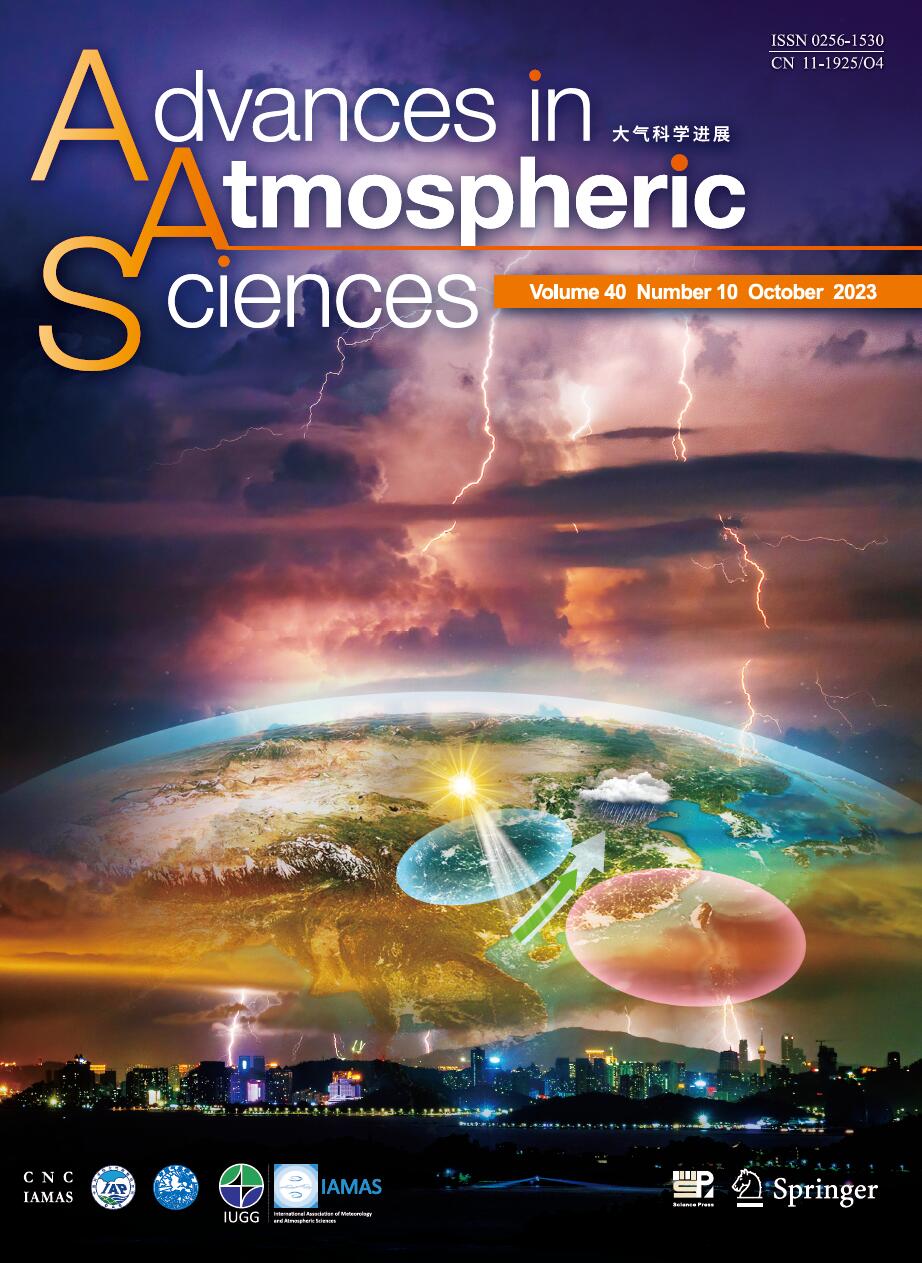| [1] |
Xuehua FAN, Xiang'ao XIA, Hongbin CHEN,
2018: Can MODIS Detect Trends in Aerosol Optical Depth over Land?, ADVANCES IN ATMOSPHERIC SCIENCES, 35, 135-145.
doi: 10.1007/s00376-017-7017-2
|
| [2] |
Xin Pei, Leiku Yang, Weiqian Ji, Shuang Chen, Xiaoqian Cheng, Xiaofeng Lu, Hongtao Wang,
2024: Applying the dark target aerosol algorithm to MERSI-II: retrieval and validation of aerosol optical depth over the ocean, ADVANCES IN ATMOSPHERIC SCIENCES.
doi: 10.1007/s00376-024-4032-y
|
| [3] |
Min ZHAO, Tie DAI, Hao WANG, Qing BAO, Yimin LIU, Hua ZHANG, Guangyu SHI,
2022: Simulating Aerosol Optical Depth and Direct Radiative Effects over the Tibetan Plateau with a High-Resolution CAS FGOALS-f3 Model, ADVANCES IN ATMOSPHERIC SCIENCES, 39, 2137-2155.
doi: 10.1007/s00376-022-1424-8
|
| [4] |
Xiaoli XIA, Jinzhong MIN, Feifei SHEN, Yuanbing WANG, Chun YANG,
2019: Aerosol Data Assimilation Using Data from Fengyun-3A and MODIS: Application to a Dust Storm over East Asia in 2011, ADVANCES IN ATMOSPHERIC SCIENCES, 36, 1-14.
doi: 10.1007/s00376-018-8075-9
|
| [5] |
Qiu Jinhuan, Nobuo Takeuchi,
2001: Effects of Aerosol Vertical Inhomogeneity on the Upwelling Radiance and Satellite Remote Sensing of Surface Reflectance, ADVANCES IN ATMOSPHERIC SCIENCES, 18, 539-553.
doi: 10.1007/s00376-001-0043-z
|
| [6] |
Hye-Ryun OH, Chang-Hoi HO, Yong-Sang CHOI,
2013: Comments on ``Direct Radiative Forcing of Anthropogenic Aerosols over Oceans from Satellite Observation", ADVANCES IN ATMOSPHERIC SCIENCES, 30, 10-14.
doi: 10.1007/s00376-012-1218-5
|
| [7] |
FENG Qian, CUI Songxue, ZHAO Wei,
2015: Effect of Particle Shape on Dust Shortwave Direct Radiative Forcing Calculations Based on MODIS Observations for a Case Study, ADVANCES IN ATMOSPHERIC SCIENCES, 32, 1266-1276.
doi: 10.1007/s00376-015-4235-3
|
| [8] |
Xiao ZHANG, Saichun TAN, Guangyu SHI,
2018: Comparison between MODIS-derived Day and Night Cloud Cover and Surface Observations over the North China Plain, ADVANCES IN ATMOSPHERIC SCIENCES, 35, 146-157.
doi: 10.1007/s00376-017-7070-x
|
| [9] |
HUO Juan, LU Daren,
2010: Preliminary Retrieval of Aerosol Optical Depth from All-sky Images, ADVANCES IN ATMOSPHERIC SCIENCES, 27, 421-426.
doi: 10.1007/s00376-009-8216-2
|
| [10] |
Qiu Jinhuan,
1986: AN APPROXIMATE EXPRESSION OF THE SKY RADIANCE IN ALMUCANTAR AND ITS APPLICATION, ADVANCES IN ATMOSPHERIC SCIENCES, 3, 1-9.
doi: 10.1007/BF02680041
|
| [11] |
Huang Runheng, Kuo_Nan Liou,
1984: REMOTE SOUNDING OF THE CIRRUS OPTICAL DEPTH AND TEMPERATURE FROM 3.7 AND 11 MICROMETER WINDOWS, ADVANCES IN ATMOSPHERIC SCIENCES, 1, 150-178.
doi: 10.1007/BF02678128
|
| [12] |
Qiu Jinhuan, Wang Hongqi, Zhou Xiuji, Lu Daren,
1985: EXPERIMENTAL STUDY OF REMOTE SENSING OF ATMOSPHERIC AEROSOL SIZE DISTRIBUTION BY COMBINED SOLAR EXTINCTION AND FORWARD SCATTERING METHOD, ADVANCES IN ATMOSPHERIC SCIENCES, 2, 307-315.
doi: 10.1007/BF02677246
|
| [13] |
GUO Jianping, XUE Yong, CAO Chunxiang, ZHANG Hao, GUANG Jie, ZHANG Xiaoye, LI Xiaowen,
2009: A Synergic Algorithm for Retrieval of Aerosol Optical Depth over Land, ADVANCES IN ATMOSPHERIC SCIENCES, 26, 973-983.
doi: 10.1007/s00376-009-7218-4
|
| [14] |
WANG Han, SUN Xiaobing, SUN Bin, LIANG Tianquan, LI Cuili, and HONG Jin,
2014: Retrieval of Aerosol Optical Properties over a Vegetation Surface Using Multi-angular, Multi-spectral, and Polarized data, ADVANCES IN ATMOSPHERIC SCIENCES, 31, 879-887.
doi: 10.1007/s00376-013-3100-5
|
| [15] |
Qiu Jinhuan, Lu Daren,
1991: On Lidar Application for Remote Sensing of the Atmosphere, ADVANCES IN ATMOSPHERIC SCIENCES, 8, 369-378.
doi: 10.1007/BF02919620
|
| [16] |
Jun LI, Alan J. GEER, Kozo OKAMOTO, Jason A. OTKIN, Zhiquan LIU, Wei HAN, Pei WANG,
2022: Satellite All-sky Infrared Radiance Assimilation: Recent Progress and Future Perspectives, ADVANCES IN ATMOSPHERIC SCIENCES, 39, 9-21.
doi: 10.1007/s00376-021-1088-9
|
| [17] |
Bo Li, Disong Fu, Ling YANG, Xuehua Fan, Dazhi Yang, Hongrong Shi, Xiang-Ao XIA,
2024: Joint Retrieval of PM2.5 Concentration and Aerosol Optical Depth over China Using Multi-Task Learning on FY-4A AGRI, ADVANCES IN ATMOSPHERIC SCIENCES.
doi: 10.1007/s00376-024-3222-y
|
| [18] |
Liu Changsheng,
1988: REMOTE SENSING OF TEMPERATURE PROFILES IN THE BOUNDARY LAYER, ADVANCES IN ATMOSPHERIC SCIENCES, 5, 67-74.
doi: 10.1007/BF02657346
|
| [19] |
Zhao Bolin,
1990: Study on Microwave Remote Sensing of Atmosphere, Cloud and Rain, ADVANCES IN ATMOSPHERIC SCIENCES, 7, 475-490.
doi: 10.1007/BF03342566
|
| [20] |
Lei SONG, Yinan WANG,
2016: A Solely Radiance-based Spectral Angular Distribution Model and Its Application in Deriving Clear-Sky Spectral Fluxes over Tropical Oceans, ADVANCES IN ATMOSPHERIC SCIENCES, 33, 259-268.
doi: 10.1007/s00376-015-5040-8
|















 AAS Website
AAS Website 
 AAS WeChat
AAS WeChat 
 DownLoad:
DownLoad: